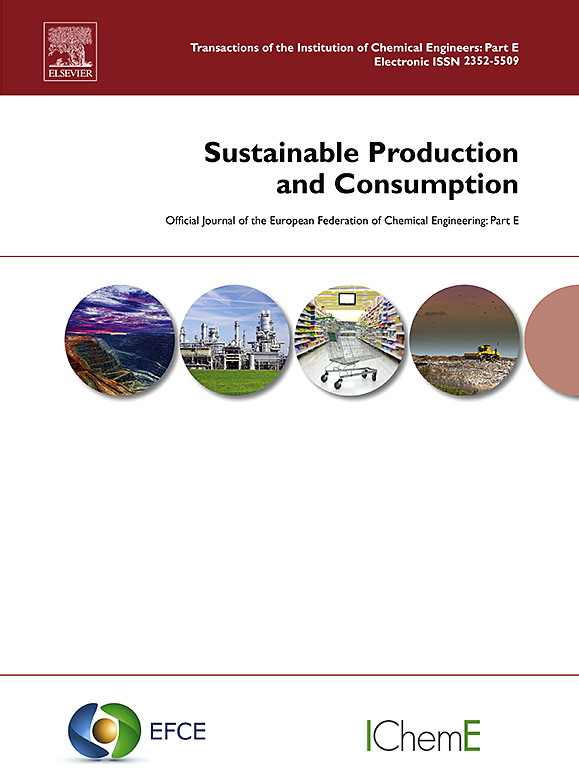促进减缓气候变化的动态生命周期评估
IF 10.9
1区 环境科学与生态学
Q1 ENVIRONMENTAL STUDIES
引用次数: 0
摘要
在评估生物质的使用对气候变化的影响时,动态生命周期评估(LCA)明确考虑了碳储存和释放的动态变化,尽管这种方法需要更多的数据并增加了计算的复杂性。因此,这项工作的目的是评估如何在以下基础上促进动态生命周期评估的应用:建模工具 Temporalis、功能单元的时间维度以及时间维度对结果准确性的贡献。首先,对 Temporalis 进行了测试和改进,证明它是执行动态生命周期评估的有效工具。其次,比较了两个功能单元:"工厂整个生命周期内生产的单位总数"(FU1)和 "t0 时生产的 1 个单位"(FU2);当工厂的生命周期比研究的时间跨度短时,结果是相同的。FU1 应用于评估整个系统对气候变化的潜在影响,与基于日历的时间轴上的气候目标相对应。相反,FU2 应用于比较生产时间分布不一致的系统,以及生成可在其他生命周期中作为背景清单数据重复使用的清单数据。第三,将影响的动态特征引起的结果变化与清单数据的不确定性引起的变化进行比较,后者并不总是很显著。在趋向于无穷大的时间范围内,对绝对全球升温潜能值的数学特性进行了研究,从而概括了以前的观测结果,并预测了其中一些从简化的时间信息中得出的结果。进一步的调查将有助于制定一种方法,在进行全面动态生命周期评估之前,仅使用简化的时间信息来选择在时间尺度上分布的流量。本文章由计算机程序翻译,如有差异,请以英文原文为准。
Facilitating dynamic life cycle assessment for climate change mitigation
Dynamic life cycle assessment (LCA) explicitly takes into account the dynamics of carbon storage and release in the impact assessment of biomass use on climate change, although such approach requires more data and increases the complexity of the calculation. The aim of this work is therefore to assess how the application of dynamic LCA can be facilitated based on: the modelling tool Temporalis, the time dimension of the functional unit, and the contribution of the time dimension to the accuracy of results. Firstly, Temporalis was tested and improved, proving to be an efficient tool for performing dynamic LCA. Secondly, two functional units were compared: ‘total number of units produced over the whole lifespan of the plant’ (FU1) and ‘1 unit produced at ’ (FU2); the results are equivalent when the lifespan of the plant is short compared to the studied time horizon. FU1 should be used for assessing the potential impact of the entire system on climate change relative to climate goals on a calendar-based timeline. Conversely, FU2 should be used for comparing systems that do not share the same temporal distribution of production and for generating inventory data that can be reused as background inventory data in other life cycles. Thirdly, the variation in results induced by the dynamic characterisation of the impact was compared with the variations induced by the uncertainties in the inventory data, which are not always significant. The mathematical properties of the absolute global warming potential were investigated for a time horizon that tends towards infinity, thus generalising previous observations and predicting some of these results derived from simplified temporal information. Further investigation would allow for the development of a method for selecting flows to be distributed over a timescale prior to a full dynamic LCA, using only simplified temporal information.
求助全文
通过发布文献求助,成功后即可免费获取论文全文。
去求助
来源期刊

Sustainable Production and Consumption
Environmental Science-Environmental Engineering
CiteScore
17.40
自引率
7.40%
发文量
389
审稿时长
13 days
期刊介绍:
Sustainable production and consumption refers to the production and utilization of goods and services in a way that benefits society, is economically viable, and has minimal environmental impact throughout its entire lifespan. Our journal is dedicated to publishing top-notch interdisciplinary research and practical studies in this emerging field. We take a distinctive approach by examining the interplay between technology, consumption patterns, and policy to identify sustainable solutions for both production and consumption systems.
 求助内容:
求助内容: 应助结果提醒方式:
应助结果提醒方式:


